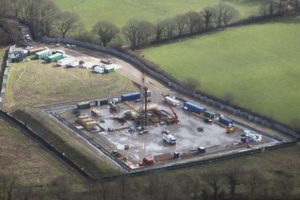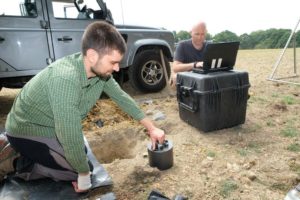Surrey Earthquakes “Swarm”: Natural Causes or Energy Exploration?
Surrey has been affected by a sudden increase in earthquakes over the last year with four happening in the last month alone. Worried residents remain concerned that seismic activity could be related to nearby oil exploration.
The latest 3.0 magnitude tremor, considered significant in UK terms, was felt in Dorking, Reigate, and Horley – all within the region of Gatwick Airport. It was felt widely as it was at a shallow depth of 2km and hit during the night when most people were asleep.
The first earthquake in what is now being dubbed as the “Surrey Swarm” occurred in April 2018 and was the first tremor to strike Surrey in the 268 years since British Geological Survey (BGS) records began. In the 11 months since there have been a further 22 tremors in the same area around Newdigate – all with varying depths and magnitudes.
After a similar sized tremor on July 5th last year, suggestions were being made that the tremors may had been linked to oil exploration works at Horse Hill, near Newdigate.

The Horse Hill oil site pictured from the air (Image courtesy of Grant Melton)
Oil Exploration to be Expanded
The Horse Hill oil exploration site, near Hookwood, is close to the epicentre but UK Oil and Gas (UKOG), the company behind it, has said there had been no subsurface activity since March 2016 when flow testing was carried out. Oil was being sought in a layer of Portland sandstone, at around 600m down, and almost 1km down in the Kimmeridge limestone.
This was well before the first tremor in April 2018.
Horse Hill Developments was granted permission for the drilling of a second borehole in November and the Environment Agency (EA) has granted a permit for extended flow testing.
Work has also restarted at the Brockham oil field after a two-year hiatus. The operators, Angus Energy, recently reported that with confirmation of oil at the site, it believed that it could become commercially successful.

Stephen Hick (left), seismologist at the University of Southampton, and David Hawthorn, of the BGS, installing a monitoring station at Horse Hill (Image courtesy of Grant Melton)
More Monitoring Needed
The BGS and Oil and Gas Authority (OGA) were asked to investigate the cause of the earthquakes. The BGS installed two new seismic monitoring stations in the area. Previously, the nearest seismograph to Newdigate had been 50km away.
One was placed at Horse Hill and another nearer to Newdigate. Later last year, a further three monitoring stations were installed nearby to allow better data collection.
A report from the BGS says:
“Our analysis shows that earthquake epicentres are tightly clustered in a 3km by 3km source zone that lies between the villages of Newdigate and Charlwood, and at a distance of approximately 8km from the Brockham oil field.
“Depths calculated using only recordings at distances of up to 10km suggest that the events are most likely to have occurred at depths of approximately 2km.”
Tremors can be induced if there is fluid injection into land, but BGS found that in Surrey, the first instance of pumping wasn’t until 9 July, by which point some of the earthquakes had already been felt.
The leader of Mole Valley District Council, Vivienne Michael, said in a statement on August 16, 2018 that the council appreciates the OGA does not believe there to be a link, but said it “cannot be completely ruled out” which left room for doubt in her mind.
Concerns over Ecological Risk
Four senior geologists have also said that there are potential risks to health and the environment. The unstable geology had not been identified at the time permission was granted for several oil exploration sites.
They cited concerns that an oil well could rupture, causing groundwater to become contaminated with oil or gas.
In a letter to The Times, Stuart Gilfillan, a Geochemistry Lecturer at the University of Edinburgh, and Richard Selley, former Professor of Petroleum Geology at Imperial College London, wrote:
“The abrupt onset of the earthquake cluster recorded by the British Geological Survey [BGS] at Newdigate since April 1 requires an explanation, and gives rise to our concerns about safety. Oil drilling, extraction and re-injection can cause earthquakes.
“There are two oil sites in the immediate area: Horse Hill and Brockham. A causal link with either well site cannot be ruled out, so we need the full picture for the risk assessment.”
The room for doubt seemed to be supported by the view that natural earthquakes tend to be deeper but it’s not unheard of to get natural earthquakes at a shallow 2km depth.
Natural Causes Declared….
A workshop chaired in October by the BGS considered three possible causes of the tremors: activity at Brockham and Horse Hill oil sites, abstraction of water from adjacent aquifers and natural causes. Fracking was not considered as an option as the report states it had not been undertaken in the area.
The resulting November report from the OGA concluded that there was no causal link between oil activity and the earthquakes. They stated that it had to be attributable to natural causes and that further monitoring via the extra sensors would start to build a picture of what was going on.
…But Exploration and Tremors Re-Start
Oil extraction resumed at Horse Hill in February and just over 200 barrels are now being produced a day.
When two new horizontal wells are drilled this spring, for which planning consent is in place, production could increase to more than 1,000 barrels per day from each of the two layers. UKOG has also submitted a planning application to further expand the site with four new wells.
Stuart Haszeldine, Professor of Carbon Capture and Storage at Edinburgh University said his team have concluded UKOG does something to vary the gas pressure in the borehole. It makes the rock spring back and release stored stress, producing a minor earthquake.
So, uncertainty remains for the residents of Mole Valley as to whether this is part of a wider seismic change in the geology of the South East of England or due to the renewed energy extraction.
One thing is for sure: something is clearly shifting below leafy Surrey.
Homebuyers are rightly concerned over the potential risks to their property in the vicinity of energy exploration sites. Our Premium Environmental Report automatically includes details of existing and proposed exploration licence sites for your client to assess whether they could be impacted by these.
For more information, visit www.futureclimateinfo.com contact us on 01732 755180 or email [email protected].
Kindly shared by Future Climate Info
















